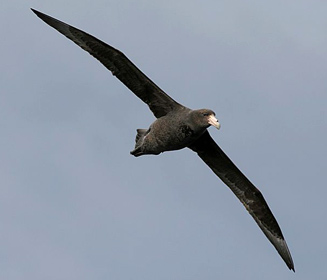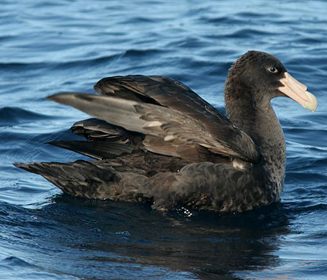|
Macronectes giganteus (Southern
giant-petrel)
Reuse nellie [Afrikaans]; Reusenellie [Afrikaans];
Zuidelijke reuzenstormvogel [Dutch]; Pétrel géant [French]; Riesensturmvogel
[German]; Pardelão-antárctico [Portuguese]
Life
> Eukaryotes >
Opisthokonta
> Metazoa (animals) >
Bilateria >
Deuterostomia > Chordata >
Craniata > Vertebrata (vertebrates) > Gnathostomata (jawed
vertebrates) > Teleostomi (teleost fish) > Osteichthyes (bony fish) > Class:
Sarcopterygii (lobe-finned
fish) > Stegocephalia (terrestrial
vertebrates) > Tetrapoda
(four-legged vertebrates) > Reptiliomorpha > Amniota >
Reptilia (reptiles) >
Romeriida > Diapsida > Archosauromorpha > Archosauria >
Dinosauria
(dinosaurs) > Saurischia > Theropoda (bipedal predatory dinosaurs) >
Coelurosauria > Maniraptora > Aves
(birds) > Order: Ciconiiformes
> Family: Procellariidae
 |
 |
| Southern giant-petrel, offshore from Cape Town, South Africa. [photo
Trevor Hardaker ©] |
Southern giant-petrel, offshore from Cape Town, South Africa. [photo Trevor Hardaker ©] |
Distribution and habitat
Breeds on sub-Antarctic islands, ice-free areas of
Antarctica, the Patagonian coast and the Falkland Islands, after which it
disperse across the southern oceans, mainly between 30-70° South although
extending further north along the west coasts of South America and southern
Africa. Here it is fairly common off South Africa and Namibia, while more scarce
to the east of southern Mozambique and the north-western corner of the region.
Predators and parasites
It is occasionally recorded as prey of sharks.
Movements and migrations
Occurs year-round off the southern African
coast, although most common in winter, as it returns to its breeding
colonies from July onwards.
Food
It is an omnivorous scavenger and predator, doing most of
its foraging by grabbing prey from the water surface or coming ashore to feed on
seabird chicks and adults. The following food items have been recorded
in its diet:
- Vertebrates
- Invertebrates
- Other
- fishery discards and offal
Threats
Vulnerable due to mortalities on longlines and human
disturbance at breeding colonies, which caused a world population decrease of
17%, and is now down to about 31 500 pairs.
References
-
Hockey PAR, Dean WRJ and Ryan PG 2005. Roberts
- Birds of southern Africa, VIIth ed. The Trustees of the John Voelcker
Bird Book Fund, Cape Town.
|
